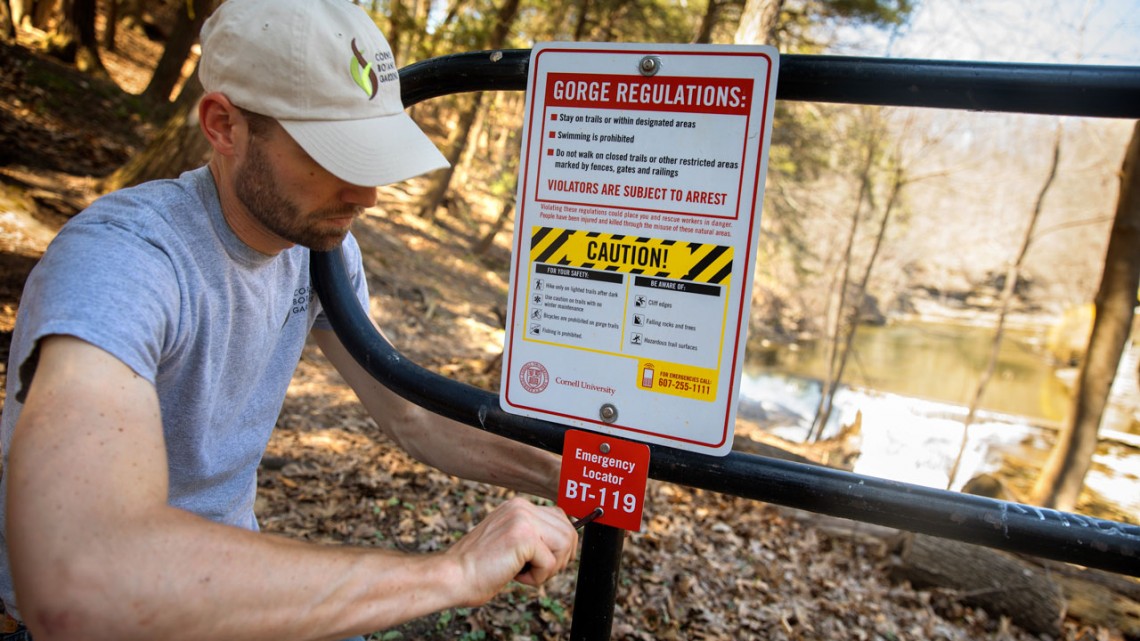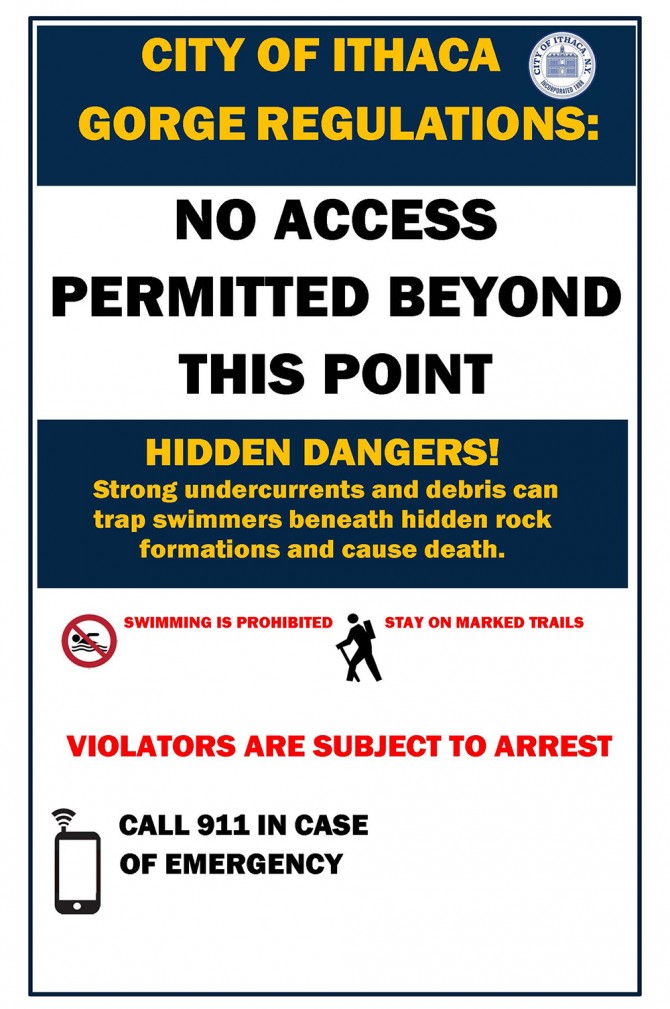
Mike Roberts, natural areas steward for Cornell Botanic Gardens, affixes an emergency locator marker to gorge safety sign.
Gorge safety highlighted in new signage, student awareness efforts
By Nancy Doolittle
With winter finally loosening its cold, gray grip on upstate New York, the recent warm, sunny days invite students and community members to hike Cornell’s gorges and other natural areas, bask on rocks and linger by plunging waters.
These activities can be rejuvenating and enriching, with opportunities to learn about the history and natural beauty of the area, as well as the hazards to avoid. All of these can be found on trail signage and online resources, or by asking any of Cornell’s patrolling gorge stewards.
But each year, visitors put themselves at risk of injury or death by ignoring cautionary signs, going off marked trails and swimming or diving in dangerous gorge waters. Several students have lost their lives in the gorges in recent years, including an incoming freshman last summer.
Now, new trail signage and a requirement for new students to watch Cornell’s online gorge safety video are meant to curtail such practices and to facilitate emergency responses.
“There are no legal outdoor swimming areas on campus,” said David Honan, Cornell deputy chief of police. “You may get referred to the Judicial Administrator or arrested if you are caught swimming in Beebe Lake or in Cascadilla or Fall Creek. The gorges are beautiful, but they are highly dangerous. People have slipped and fallen on the steep, unstable slopes and muddy, slippery rocks, and have lost their lives in the waters’ whirlpools and undercurrents.”
Past tragedies bear out Honan’s warning. Three Cornell students lost their lives in spring and summer 2011 while swimming or off-trail hiking in Fall Creek Gorge: Kendrick Castro ’11; Nathaniel Rand ’12 (for whom Cornell’s gorge safety education program is named) and Stanislaw J. Jaworski, a visiting graduate student from the University of Gdansk, Poland.
And last August, Winston Samuel Perez Ventura ’22 drowned while swimming in the gorge near Fall Creek Drive after participating in the Prefreshman Summer Program.
Honan advises all hikers to stay on marked trails and swimmers to use nearby parks with designated swimming areas and lifeguards on duty, including Buttermilk Falls and Robert H. Treman state parks. Several other off-campus safe swimming options are available, as well as Helen Newman and Teagle Hall swimming pools.
Additional measures have been implemented to deter risky behavior. Complementing the gorge safety signs Cornell already has in place, the City of Ithaca is in the process of installing new signs in its Ithaca Falls and Six-Mile Creek natural areas – warning of the dangers and illegality of swimming there.
Cornell has also worked with the city to eliminate use of “Ezra’s Tunnel,” a 200-foot-long former industrial sluiceway carved through rock in the early 1830s by Ezra Cornell. Two barriers to this tunnel, which gave access to a dangerous and sometimes deadly section of Fall Creek, were installed in January.
To further build student awareness of the dangers inherent in gorge environments, and of how to safely experience their beauty, Cornell will include the university’s gorge safety video in the list of requirements in the New Students “To Do List” this fall in addition to offering new-student orientation hikes around the gorges.
Cornell and the city are also enhancing their first-responder abilities by installing emergency locator signs along gorge trails. Should a gorge visitor twist an ankle, trip over a tree root or otherwise need emergency assistance, that visitor or a bystander can reference the closest emergency locator sign when calling 911 or Cornell University Police, which will give first responders an exact location of the incident.
“City officials had voiced concerns about emergency response within the Six-Mile Creek Natural Area, which is on city property and is an illegal area for swimming,” said Todd Bittner, director of natural areas at Cornell Botanic Gardens and chair of the university’s Gorge Safety Committee. “If anyone has an accident there, it’s difficult to describe exactly where they are to first responders. The city decided to install locator signs at Six-Mile Creek, and we have adopted the same practice at Cornell.”
Cornell’s red emergency locator signs, with lettering and numbers, look similar to green markers along county and state roads. They have been added to safety regulation signs in Cascadilla Creek and Fall Creek gorges and Hemlock Gorge at Beebe Lake. Letters (BT for Beebe Lake Trail; CD for Cascadilla Gorge; FG for Fall Creek Gorge) and numbers that follow are coordinated with emergency response maps at the Cornell University Police. The signs indicate the nearest trail intersection and possible modes of access.
Bittner said the city’s emergency locator signs will complement those at Cornell.
Media Contact
Get Cornell news delivered right to your inbox.
Subscribe

